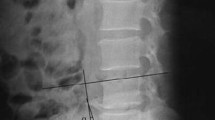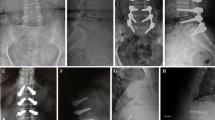Summary
A total of 190 patients treated micorsurgically for a virgin single level lumbar disc herniation were examined physically after a mean follow-up period of 3 years (range 21–68 months). Included were 99 (52%) men and 91 (48%) women with a mean age of 42 years. During the observation period, sciatica had completely recovered or markedly diminished in 172 (90%) patients, and 142 (75%) patients had returned to work. However, as many as 29% of the patients occasionally suffered from low back pain.
Clinical examination revealed various signs and symptoms of segmental instability of the lumbar spine in 22% of the surgical patients. There was a significant association between postoperative instability and unsatisfactory long-term outcome: of the 42 patients with instability, 62% suffered from low back pain and 45% were on sick leave or retired because of the back, while the corresponding numbers for those patients without instability were 20% and 8%, respectively (p<0.0001). Moreover, the mean value of the Oswestry index in instability patients was as high as 34% (SD 12), indicating moderate disability, whereas a significantly (p=0.0001) lower Oswestry Index 16% (SD 13), indicating minimal disability, was detected in patients without instability.
Similar content being viewed by others
References
Andrews DW, Lavyne MH (1990) Retrospective analysis of microsurgical and standard lumbar discectomy. Spine 15: 329–335
Barr JS (1951) Protruded disc and painful backs. J Bone Joint Surg 33-B: 3–4
Boden SD, Wiesel SW (1990) Lumbosacral segmental motion in normal individuals. Have we been measuring instability properly? Spine 15: 571–576
Caspar W (1977) A new surgical procedure for lumbar disc herniation causing less tissue damage through a microsurgical approach. Adv Tech Stand Neurosurg 4: 74–77
Caspar W, Campbell B, Barbier DD, Kretschmmer R, Gottfried Y (1991) The Caspar microsugical discectomy and comparison with a conventional standard lumbar disc procedure. Neurosurgery 28: 78–87
Dupuis PR, Yong-Hing K, Cassidy JD, Kirkaldy-Willis WH (1985) Radiologic diagnosis of degenerative lumbar spinal instability. Spine 10: 262–276
Dvorak J, Panjabi MM, Novotny JE, Chang DG, Grob D (1991) Clinical validation of functional flexion-extension roentgenograms of the lumbar spine. Spine 16: 943–950
Ebara S, Harada T, Hosono N, Inoue M, Tanaka M, Morimoto Y, Ono K (1992) Intraoperative measurement of lumbar spinal instability. Spine 17(3S): S44-S50
Ebeling U, Reichenbach W, Reulen H-J (1986) Results of microsurgical lumbar discectomy. Review of 485 patients. Acta Neurochir (Wien) 81: 45–52
Fairbank JCT, Couper J, Davies JB, O'Brien JP (1980) The Oswestry low back pain disability questionnaire. Physiotherapy 66: 271–273
Feffer HL, Wiesel SW, Cuckler JM, Rothman RH (1985) Degenerative spondylolisthesis: to fuse or not to fuse. Spine 10: 287–289
Frymoyer JW, Hanley E, Howe J, Kuhlmann D, Matteri R (1978) Disc excision and spine fusion in the management of lumbar disc disease. A minimum ten-year follow-up. Spine 3: 1–6
Frymoyer JW, Hanley EN, Howe J, Kuhlmann D, Matteri RE (1979) A comparison of radiographic findings in fusion and in nonfusion patients ten or more years following lumbar disc surgery. Spine 4: 435–440
Frymoyer JW (1981) The role of spine fusion. Question 3. Spine 6: 284–290
Frymoyer JW, Selby DK (1985) Segmental instability. Rationale for treatment. Spine 10: 280–286
Goald HJ (1978) Microlumbar discectomy: follow-up of 147 patients. Spine 3: 183–185
Gertzbein SD, Seligman J, Holtby R, Chan KH, Kapasouri A, Tile M, Cruicskhank B (1985) Centrode patterns and segmental instability in degenerative disc disease. Spine 10: 257–261
Hakelius A (1970) Prognosis in sciatica. A clinical follow-up of surgical and non-surgical treatment. Acta Orthop Scand [Suppl] 129: 3–76
Hirsch C (1959) Studies on the pathology of low back pain. J Bone Joint Surg (Br) 41: 237–243
Ida Y, Kataoka O, Sho T, Sumi M, Hirose T, Bessho Y, Kobayashi D (1990) Postoperative lumbar spinal instability occurring or progressing secondary to laminectomy. Spine 15: 1186–1189
Johnsson K-E, Redlund-Johnell I, Uden A, Willner S (1989) Preoperative and postoperative instability in lumbar spinal stenosis. Spine 14: 591–593
Kirkaldy-Willis WH, Farfan HF (1982) Instability of the lumbar spine. Clin Orthop 165: 110–123
Knutsson F (1944) The instability associated with disk degenration in the lumbar spine. Acta Radiol 25: 593–609
Kotilainen E, Valtonen S, Carlson C-Å (1993) Microsurgical treatment of lumbar disc herniation: follow-up of 237 patients. Acta Neurochir (Wien) 120: 143–149
Loew F, Caspar W (1978) Surgical approach to the lumbar disc herniations. Adv Tech Stand Neurosurg 5: 153–174
MacNab I (1971) The traction spur: an indicator of segmental instability. J Bone Joint Surg (Am) 53: 663–670
Maroon J, Abla A (1985) Microdiscectomy versus chemonucleolysis. Neurosurgery 16: 644–649
Morgan FP, King T (1957) Primary instability of lumbar vertebrae as a common cause of low back pain. J Bone Joint Surg (Br) 39: 6–22
Nachemson A (1981) The role of spine fusion. Question 8. Spine 6: 306–307
Nachemson A (1985) Eumbar spine instability: a critical update and symposium summary. Spine 10: 290–291
Nachemson AL (1991) Instability of the lumbar spine. Pathology, treatment, and clinical evaluation. Neurosurg Clin North Am 2: 785–790
Naylor A (1974) The late results of laminectomy for lumbar disc prolapse. A review after ten to twenty-five years. J Bone Joint Surg (Br) 56: 17–29
O'Brien JP, Dawson MHO, Heard CW, Momberger G, Speck G, Weatherly CR (1986) Simultaneous combined anterior and posterior fusion. A surgical solution for failed spinal surgery with a brief review of the first 150 patients. Clin Orthop 203: 191–195
Pappas CTE, Harrington T, Sonntag VKH (1992) Outcome analysis in 654 surgically treated lumbar disc herniations. Nerosurgery 30: 862–866
Paris SV (1985) Physical signs of instability. Spine 10: 277–279
Pope MH, Panjabi M (1985) Biomechanical definitions of spinal instability. Spine 10: 255–256
Rydevik BL (1992) Pathophysiology of the neural elements in the lumbar spine. J Spinal Disord 5: 139–140
Sano S, Yokokura S, Nagata Y, Young SZ (1990) Unstable lumbar spine without hypermobility in postlaminectomy cases. Mechanism of symptoms and effect of spinal fusion with and without spinal instrumentation. Spine 15: 1190–1197
SAS Institute Inc (1987) SAS/STAT guide for personal computers. Version 6. Edition, Cary, NC
Stokes IA, Frymoyer JW (1987) Segmental motion and instability. Spine 12: 688–691
Spangfort EV (1972) The lumbar disc herniation. A computeraided analysis of 2504 operations. Acta Orthop Scand [Suppl] 142: 5–95
Waddell G, Kummel EG, Lotto WN, Graham JD, Hall H, McCulloch JA (1979) Failed lumbar disc surgery and repeat surgery following industrial injuries. J Bone Joint Surg (Am) 61: 201–207
Weber H (1978) Lumbar disc herniation. A prospective study of prognostic factors including a controlled trial. Part II. J Oslo City Hosp 28: 89–113
Weber H (1983) Lumbar disc herniation. A controlled, prospective study with ten years of observation. Spine 8: 131–140
Weiler PJ, Eng P, King GJ, Gertzbein SD (1990) Analysis of sagittal plane instability of the lumbar spine in vivo. Spine 15: 1300–1306
Author information
Authors and Affiliations
Rights and permissions
About this article
Cite this article
Kotilainen, E., Valtonen, S. Clinical instability of the lumbar spine after microdiscectomy. Acta neurochir 125, 120–126 (1993). https://doi.org/10.1007/BF01401838
Issue Date:
DOI: https://doi.org/10.1007/BF01401838




